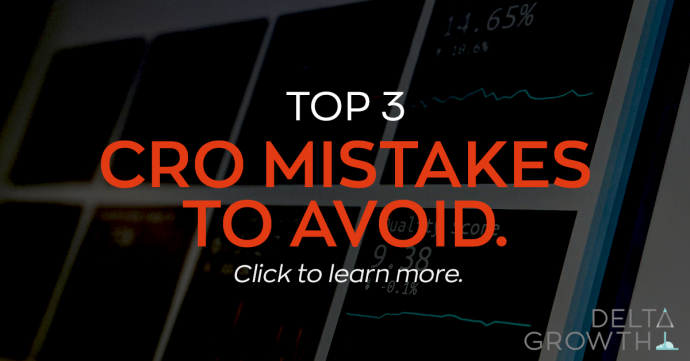Bounce rate in GA4 and why it still matters for your site’s success
The role and importance of Bounce Rate in SEO seems to be debated almost as much as pineapple on pizza. At Delta Growth, we stand by both (pineapple included). Here’s why we believe Bounce Rate still matters, even if Google doesn’t emphasize it anymore.
What does Bounce Rate mean in SEO?
Bounce rate is the percentage of users who leave your page after a short, single session without taking any action. In SEO, this indicates that they visited your page, but for whatever reason, they spent a very short amount of time (if any) on-page before clicking out. This means limited scrolling, no clicks, no engagement.
Bounce rate directly correlates with dwell time, or the total time a user spends on-site interacting, reading, and completing their journey—potentially converting.
Simply put, bounce rate refers to the effectiveness of your on-site content and your visitor’s willingness to stick around (i.e., like rolling up to a dead, soulless party with pineapple-less pizza – you bounce).

How is Bounce Rate Calculated?
Traditional Bounce Rate (Universal Analytics):
Bounce rate was originally calculated as the percentage of single-page sessions out of total sessions:
Bounce Rate = Number of Single-Page Sessions ÷ Total Site Sessions
Example:
If your site had 1,000 total sessions in a month, and 650 of those sessions involved users leaving after viewing only one page, the bounce rate would be:
650÷1000=0.65×100→65% bounce rate
This formula provided a simple measure of how often users left your site without engaging further. A high bounce rate traditionally indicated that users weren’t finding what they expected, or the content wasn’t compelling enough to encourage them to navigate to other pages.
Bounce Rate in GA4 (2025 and beyond):
Nowadays, Google’s focus on bounce rate as a factor has waned, and a new definition has emerged – instead emphasizing “engaged sessions”, which meet at least one of the following conditions:
- Lasts longer than 10 seconds
- Includes two or more pageviews or screenviews
- Triggers a key event (like a form submission, video play, or conversion)
This new calculation reflects the shift from counting only single-page exits to measuring meaningful interaction. A user who spends time reading, scrolling, watching videos, or triggering events is considered engaged, even if they only visit one page. Conversely, a visitor who immediately leaves without any interaction counts as a bounce.
The focus is no longer simply “visit and leave” but meaningful interactions. GA4 emphasizes engaged sessions, engagement time, and conversion events—giving a more accurate picture of user behaviour.
So, are bounce rates even relevant anymore?
Google’s official stance on bounce rate, specifically as a GA4 metric, is that bounce rate is NOT used as a hard ranking factor on SEO performance and ranking. It has actually been removed as a factor and has been merged into the new “engagement metrics”, which include engagement time and engaged sessions.
That being said…
Bounce rate is still important, regardless of whether or not Google considers it an official SEO ranking factor – specifically in terms of user behaviour and experience and overall site health diagnostics, which definitely (albeit indirectly) affects your ranking. If people aren’t staying on your page, there’s a reason – and you need to find out why. Could it be that your site is loading too slowly? Is the content relevant, and does it align with what a user would expect to see? Is it navigable and usable? Google certainly cares about those, and bounce rate can help you pinpoint where you might be going wrong.
So, the short answer is – YES. Bounce rate still matters, even if Google doesn’t say so. Ignoring your bounce rate might not be the be-all and end-all, but monitoring it helps identify pages where users spend less time than expected, guiding improvements.
Why Is Your Bounce Rate So high?
Your Bounce Rate might be high for many reasons:
- Technical Issues
404s, broken assets, JavaScript and platform failures, and non-responsive design can all contribute to a higher bounce rate. To avoid/fix technical issues, regularly check Search Console and perform UX tests to catch hiccups before users do.
- Page Speed/Web Vitals
Site speed is an important Google ranking metric. Slow sites provide a poor experience, and load speeds longer than 2.5 seconds may annoy your visitors to the point of leaving. Keep an eye on PageSpeed Insights to identify speed-related bounces.
- Misalignment with User Expectations / Search Intent
Ensure your content aligns with the title and meta description. If a user clicks on your website because the title and meta say “the benefits of purple fuzzy socks”, you need to make sure the content is all about fuzzy socks, so as not to mislead anyone.
- Disengaging or irrelevant content
Similar to the above, but with more of a focus on relevance. Would a user WANT to be on this page? Is it engaging, interesting, resourceful, and informative? Stay on topic, and make sure you’re considering proper hierarchy, CTAs, and straightforward, relevant content that can satisfy a user’s needs (or your target conversion).
- Intrusive UI / UX issues
Over-aggressive pop-ups, banners, ads, and interstitials can annoy your users to the point of leaving. Go easy on the popups and give people exploring your site a chance to breathe.
- Self-Sufficient Content
If a user can get their answer too quickly, that can also impact your bounce and engagement rates. The content itself answers the query fully, so users don’t need to click further. That could lead to high bounce, but not a bad outcome, which is also likely part of why Google chose to move more towards engagement metrics, rather than strictly bounce.

How to reduce bounce rate
- Introduce Key Events
Set up meaningful events in GA4 to track user interactions such as scroll depth, video plays, button clicks, and form submissions. These events help define “engaged sessions” and give insight into how users interact with your content.
- Review Engagement Metrics in GA4
Open GA4 and examine engagement metrics like engagement rate, average engagement time, and engaged sessions. Identify pages with unusually low engagement or high unengaged sessions as priorities for improvement.
- Perform a Technical Audit
Check page speed, mobile responsiveness, broken links, and Core Web Vitals. Slow load times or technical errors can cause visitors to leave before interacting with your content. Match Content to Intent
- Get Higher Quality Traffic
Audit your traffic sources. High bounce rates can result from poorly targeted ads, misleading meta descriptions, or irrelevant keywords.
- Test & Iterate
Experiment with headlines, CTAs, layout, and interactive elements—iterate based on results to continually improve user experience and reduce bounce.
Long Story Short…
Bounce rate may have evolved, but it’s far from gone. It’s still a key indicator of user engagement and site health. While GA4 redefines it around engaged sessions rather than single-page exits, high bounce rates can still signal issues that indirectly affect SEO and rankings.
The good news: you can track and analyze bounce rate in GA4, use it to understand user behavior, and take targeted action to improve engagement and overall site performance—so your site doesn’t feel like a pizza party without pineapple: uninviting and abandoned.
How delta Growth can help reduce your bounce rate & Get More engagement
Delta Growth helps turn visits into meaningful engagement. We track key GA4 metrics, optimize content and UX, and run targeted SEO and paid media strategies to attract the right traffic. Through CRO, marketing automation, and ongoing reporting, we identify issues, test solutions, and continuously improve site performance—reducing bounce rates and increasing user engagement.
Book a Discovery Call with Delta Growth Today
Answers to common questions about bounce rate
- What’s a “good” bounce rate?
It depends. Blogs often sit in 40–60%; lead pages and apps should be lower. Always compare to your user intent.
- Does bounce rate affect SEO rankings?
Not directly — Google says Analytics signals aren’t used as ranking inputs — but poor engagement correlates with poor UX, which does affect ranking indirectly.
- What replaced bounce rate in GA4?
GA4 emphasizes engagement rate, engaged sessions, and average engagement time. Bounce rate in GA4 is the inverse of engagement rate.
- What is dwell time?
Time a user spends on a page after clicking a search result and before returning to the SERP. It’s a user-behavior signal (not a GA standard metric).




